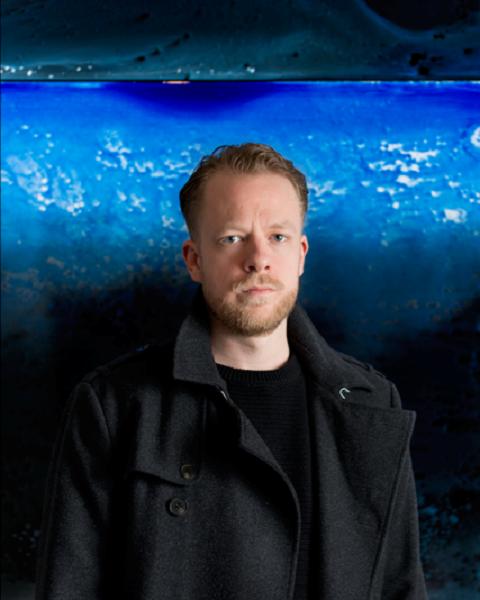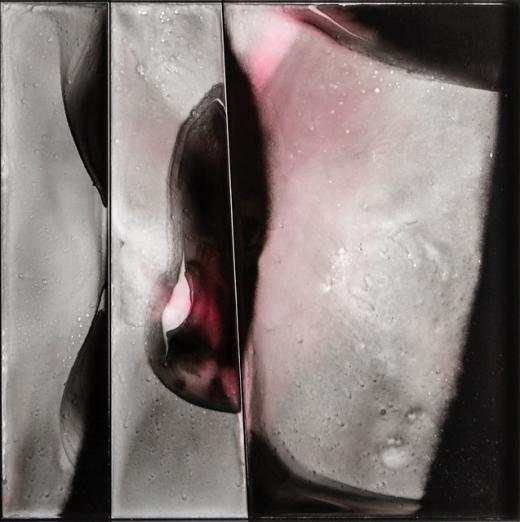Pre-interview: Veit Schmidleitner
Pre-interview: Veit Schmidleitner

Everything was ready for the opening of Veit Schmidleitner's first solo exhibition in Berlin at the time we arrived to Ronewa Art Gallery. With the excitement of a newcomer and the confidence of an expert in the self-invented field, Veit showed us his mesmerising new series of metal paintings titled "Coupure“. The series consists of fourteen new pieces made especially for the show.
With his varied background in car varnishing, photography, film and graphic design, Veit manages to pour together different elements of his creative upbringing into a unique form of expression. We sat down with the artist to discover more about his art practice and the complex process of creating skillful art with materials typically reserved for heavy industry.
What is your series of paintings presented in "Coupure: Cutting Through Spaces" about?
In the last few years I developed my styles of painting. They all refer to varnish, which is the main material I use. All of my paintings are made of metal. I work with stainless steel, steel, copper, brass, aluminium. For this show I was working with the "Coupure" series. It is about different cuts in the paintings. Those cuts divide canvas into different segments, into panels which are bent in different ways, some more subtle than the others. There are two different layers you find yourself in. First of all, the reflection which comes from the clearcoat surface. Then, of course, there is the layer where you see the actual painting – the colors, the structures, and the textures. I played around with the layers so that the observer is exposed to those two different levels. First you have the reflection of yourself in the painting, and then on the other level you see the painting itself. I really like to incorporate the viewer into the experience. It makes every experience unique for the person looking at the painting. "Coupure“ also describes the act of cutting, and of cutting the reflections. The painting reflects things that are hanging in the space, and I play around with that and twist and transform the space that is reflected in the painting.

Veit Schmidleitner, "Coupure – Cutting Through Spaces" @ Ronewa Art Gallery
What else can you tell us about the process of making the pieces?
The paintings are made from steel, and the different panels you see are cut with laser. I sketch down the idea of making a canvas, and then everything is transferred to a graphical program such as Illustrator, or any other vector program. The laser cuts everything, and then all those pieces are welded together. On the backside of each painting you have the constructional side of it. You see many holes and screws sticking out. Then it comes down to manipulating the physical surface. I had an education as a car painter, but that was just a necessity to get an in-depth idea of how to work with these materials. I was working with varnish since I was a little kid. The first time I started was when I was eleven. My dad always engaged me to use all kinds of materials because it was my dream to become an artist from very early days. Lacquer was something that got stuck with me. I'm not really interested in cars, but I was always very interested in the colors used on cars because you rarely see them somewhere else, only on cars. And that is such a sad thing in my opinion, because those colors have so many unique properties. For example, you have different lacquers that withstand heat up to 300 degrees, even higher on engines and such things. The floor you're walking on is painted with some kind of lacquer. The chairs here as well. To incorporate these fantastic colors into paintings was something I was always dreaming about, and that's what I've been working on in the last four years.
The colors are amazing. How do you get these textures with the paint?
What is really important for me is to know about the history of working with lacquers. Asian countries, especially Japan and China, have a long tradition and are well known for the mastery of working with varnishes. I was always researching and trying to find people who work with these materials in a very unique way. Through that research and studies I kind of developed my own style of painting. When you're working with metals you have to have a profound knowledge of how to build a surface that makes it possible to paint on it. First of all you have a primer which is kind of like putting some acid to metal to make the color stick. Everything is sanded before. Then I apply a base, but the painting act actually starts while you're thinking about making a new one. You have to be aware of all the details, everything has to be super precise, everything is measured. When I am making a painting that is 1,80 x 1,20 meter, everything is in milimeters, so it's 1800 x 1200 mm, and everything fits perfectly together. After you've done this part, you move on to building up a painting. You can imagine it like the traditional oil painting where you're applying rapid glue for example, and then you build up your underpainting and your overpainting, glares and all of these things. It's more or less like that with those paintings. It's a complicated build-up. But in fact, these paintings are mainly based with 2K coat. It's a chemical reaction and has two components. The main base is the pigment, the binder and the hardener. And then in the chemical process the painting is dried. After it is sanded I apply gouache, which is liquid watercolor. And this is more or less what gives it the color. I really like the idea of having such a strong contrast and such a weird mix of materials, because you don't really see anyone painting on metal with watercolor. It's so weird. It's actually made for paper, but I like the idea of pushing technology, as well as the aesthetic appeal of the paintings. You don't really see anything like it in the industry.

Veit Schmidleitner, "Coupure N. 15", 2017
What or who influences your work the most?
When I started studying graphic design in Marbella in Spain, I wasn't really influenced by artists. I was always into art and interested in painters and sculptors, but I never really saw myself becoming a real full time artist, committing my whole life into it. I'm really influenced by two different worlds. One is the industry – German industry such as producing metal parts, car industry, machines, what can those machines do and what can I do with them. For example, I could use laser for making parts for machines. But for me every machine also has the ability to make artworks. You need to learn the craft first to understand it completely, and then you can transfer the abilities of those machines into art. That's one road I'm really interested in, it's the industrial side of my paintings, but the other side is of course other artists. I must say that I really like the idea of not getting too influenced. I like the idea of putting an artist on a lonely island, giving him materials and seeing what he will come up with, so that you really get the inner core of somebody's work, something that is not fake or influenced. Of course, in this world you can't isolate yourself to a degree like that, unless you are somewhere in a cabin in the woods. From the art side I'm influenced by Richard Serra, I think he is a really outstanding artist when it comes to working with metals. Painters... Fanz Kline, Mark Rotho. There are some contemporary artists as well, but I'm really trying to keep my eye on the canvas and research in my field. I try to develop my own thing.
What else have you been working on? What are you planning to do next?
The last months have been really crazy. I was exhibiting at Contemporary Art Ruhr which was a great opportunity to see other people my age exhibiting their new things. Through that I got into a group exhibition in London, in The Store Street Gallery. I got in touch with Roger Washington who was really interested in working with me, and so far it has been a great collaboration. We had a really great time setting up the whole idea behind this exhibition. All of the14 paintings were made especially for this occasion. The next thing I am going to exhibit at is in Herten in a coal mining facility. It's abandoned but it's used for events such as this art fair. I'm going to exhibit there, and maybe in Basel this year. When it comes to art, I would love to explore the "Coupure“ series more and see what kind of cuts I could implement in the idea of making those paintings. I think the next step I'm going to take is to incorporate more of the idea of materialism. Right now I'm working with metals, but I'm really into fabrics lately. Not using and showing fabrics, but rather immitating the behavior of fabrics on metal. It sounds really strange, but I think that there is a huge unexplored field to imprint. I'm going to start that in a few months when everything is a bit more chill, and then I'm going back to my studio and getting back into the scientific field of my work.
From a young artist to a young artist:
If I can give advice, that would be – you need to practice your stamina. I think nowadays, because of Instagram, Facebook, Twitter, Tumblr, all of those possibilities to self-publish your art, people tend to rush things. They are developing a style, or just immitating a style they think is really great, but in fact it could be questionable and they could do much better if they would give themselves time. But if you commit your life to arts and you really want to make it, you also want to push your art outside and make people see what you are doing and get feedback. I think that in developing as a character and as an artist it is really essential to make a bulletproof statement. For that you need time, you need to really research yourself, try to find your special niche, and try to really put everything into it. You had so many artists in the past who had decades of financial hardship and stressful times making a living. Committing your life to arts and trying to do the best possible, and then also living the real world, trying to pay the bills, trying to live a life and be a part of the society is sometimes almost impossible. And then the misunderstanding of people not related to arts. Never expect your parents to understand what you do, or even your girlfriend or your friends. You really need to isolate yourself and go for it, just listen to that inner voice you have that needs to produce these things. Don't get your art judged by money, people buying it, or people being interested in it. Try to really find the key to your expression. Don't push things too much, just let it flow and develop, and when you have the feeling that there is something, invest even more time into it to make it bulletproof.
* * * * *
Veit Schmidleitner, "Coupure – Cutting Through Spaces"
March 2 – April 5, 2017
Ronewa Art Gallery
more info